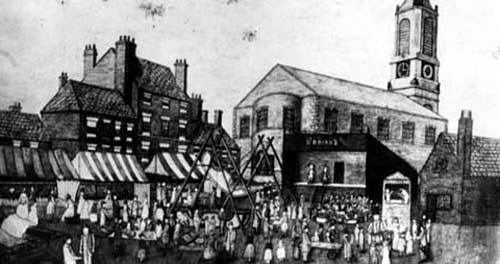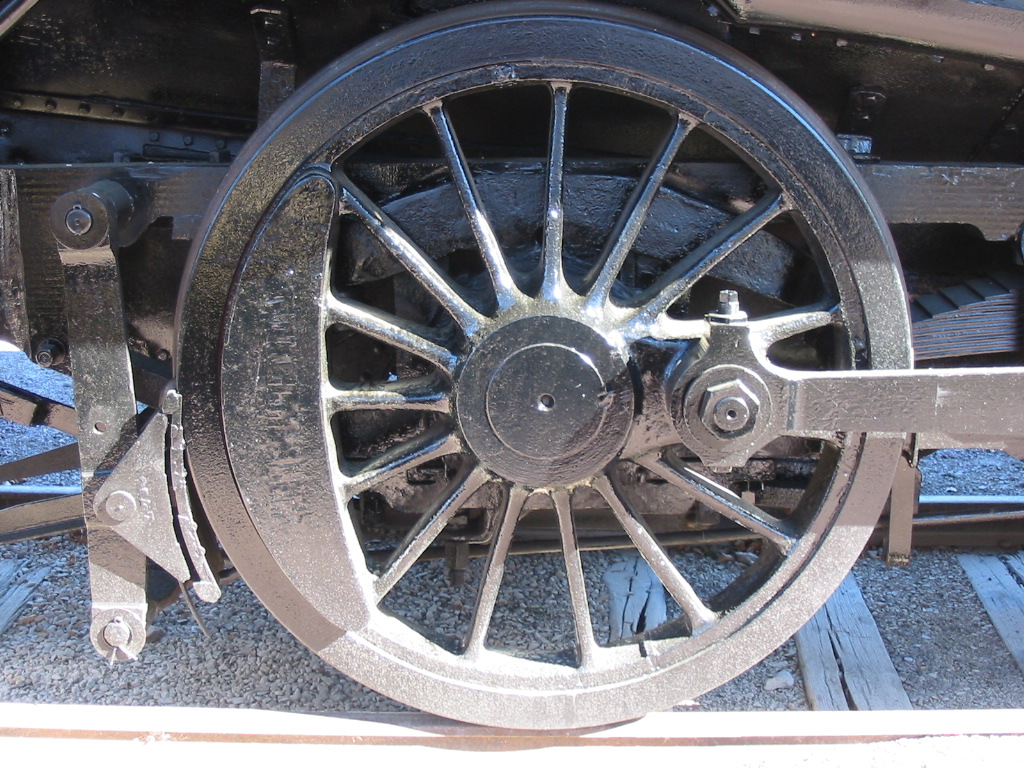|
Middleton Railway
The Middleton Railway is the world's oldest continuously working railway, situated in Leeds, West Yorkshire, England. It was founded in 1758 and is now a heritage railway, run by volunteers from The Middleton Railway Trust Ltd. since 1960. The railway operates passenger services at weekends and on public holidays over approximately of track between its headquarters at Moor Road railway station, Moor Road, in Hunslet, and Park Halt railway station, Park Halt, on the outskirts of Middleton park, Middleton Park. Origins: Middleton colliery Coal has been worked in Middleton, West Yorkshire, Middleton since the 13th century, from bell pits, gin pits and later "day level" or adits. Anne Leigh, heiress to the Middleton Estates, married Ralph Brandling from Felling (UK), Felling near Gateshead on the River Tyne. They lived in Gosforth and left running of the Middleton pits to agents. Brandling of Newcastle#Notable Brandlings, Charles Brandling was their successor. In 1754, Richa ... [...More Info...] [...Related Items...] OR: [Wikipedia] [Google] [Baidu] |
Hunslet
Hunslet () is an inner-city area in south Leeds, West Yorkshire, England. It is southeast of the Leeds city centre, city centre and has an industrial past. It is situated in the Hunslet and Riverside (ward), Hunslet and Riverside ward of Leeds City Council and Leeds South (UK Parliament constituency), Leeds South parliamentary constituency. The population of the previous City and Hunslet council ward at the 2011 census was 33,705. Many engineering companies were based in Hunslet, including John Fowler & Co. manufacturers of traction engines and steam rollers, the Hunslet Engine Company builders of locomotives (including those used during the construction of the Channel Tunnel), Kitson & Co., Manning Wardle and Hudswell Clarke. Many railway locomotives were built in the Jack Lane area of Hunslet. The area has a mixture of modern and 19th century industrial buildings, terraced house, terraced housing and 20th century housing. It is an area that has grown up significantly aroun ... [...More Info...] [...Related Items...] OR: [Wikipedia] [Google] [Baidu] |
Bell Pit
A bell pit is a primitive method of mining coal, iron ore, or other minerals lying near the surface. Operation A shaft is sunk to reach the mineral which is excavated by miners, transported to the surface by a winch, and removed by means of a bucket, much like a well. The bottom of the shaft is enlarged and a sloping roof is created as the desired mineral and surrounding rock is removed – giving its name because the pit in cross section resembles a bell. Typically, no supports were used, and mining continued outwards until the cavity became too dangerous or collapsed at which point another mine was started, often in close proximity. Example and illustrated description This type of mine was in use in prehistoric times, the Middle Ages, and a few continued in use until the early 20th century in the region around Ford, Northumberland. Such pits are common at prehistoric flint working sites such as Grime's Graves in Norfolk and also in the coal mining areas of Yorkshire, the For ... [...More Info...] [...Related Items...] OR: [Wikipedia] [Google] [Baidu] |
Rail Adhesion
An adhesion railway relies on adhesion traction to move the train, and is the most widespread and common type of railway in the world. Adhesion traction is the friction between the drive wheels and the steel rail. Since the vast majority of railways are adhesion railways, the term ''adhesion railway'' is used only when it is necessary to distinguish adhesion railways from railways moved by other means, such as by a stationary engine pulling on a cable attached to the cars or by a pinion meshing with a rack. The friction between the wheels and rails occurs in the wheel–rail interface or contact patch. The traction force, the braking forces and the centering forces all contribute to stable running. However, running friction increases costs, due to higher fuel consumption and increased maintenance needed to address fatigue damage and wear on rail heads and on the wheel rims and rail movement from traction and braking forces. Variation of friction coefficient Traction or fric ... [...More Info...] [...Related Items...] OR: [Wikipedia] [Google] [Baidu] |
John Blenkinsop
John Blenkinsop (1783 – 22 January 1831) was an English mining engineer and an inventor of steam locomotives, who designed the first practical railway locomotive. He was born in Felling, County Durham, the son of a stonemason and was apprenticed to his cousin, Thomas Barnes, a Northumberland coal viewer. From 1808 he became agent to Charles John Brandling, who owned collieries on his Middleton estate near Leeds and whose family came from Felling. From then until his death, Blenkinsop lived at Middleton Hall on Town Street, Middleton, built in the 17th century as the Brandling family's Middleton home (they used the far more modern Middleton Lodge when visiting from their Tyneside homes). Blenkinsop and the Middleton Railway In 1758 the Brandlings had built a wooden wagonway to carry coal into Leeds, using horse-drawn vehicles, now known as the Middleton Railway. Not all the land traversed by the wagonway belonged to Brandling, and it was the first railway to be autho ... [...More Info...] [...Related Items...] OR: [Wikipedia] [Google] [Baidu] |
Wayleave
An easement is a nonpossessory right to use or enter onto the real property of another without possessing it. It is "best typified in the right of way which one landowner, A, may enjoy over the land of another, B". An easement is a property right and type of incorporeal property in itself at common law in most jurisdictions. An easement is similar to real covenants and equitable servitudes. In the United States, the Restatement (Third) of Property takes steps to merge these concepts as servitudes. Easements are helpful for providing a 'limited right to use another person's land for a stated purpose. For example, an easement may allow someone to use a road on their neighbor’s land to get to their own.' Another example is someone's right to fish in a privately owned pond, or to have access to a public beach. The rights of an easement holder vary substantially among jurisdictions. Types Historically, common law courts would enforce only four types of easements: # Easemen ... [...More Info...] [...Related Items...] OR: [Wikipedia] [Google] [Baidu] |
Colliery
Coal mining is the process of extracting coal from the ground or from a mine. Coal is valued for its energy content and since the 1880s has been widely used to generate electricity. Steel and cement industries use coal as a fuel for extraction of iron from iron ore and for cement production. In the United Kingdom The United Kingdom of Great Britain and Northern Ireland, commonly known as the United Kingdom (UK) or Britain, is a country in Northwestern Europe, off the coast of European mainland, the continental mainland. It comprises England, Scotlan ... and South Africa, a coal mine and its structures are a colliery, a coal mine is called a "pit", and above-ground mining structures are referred to as a "pit head". In Australia, "colliery" generally refers to an underground coal mine. Coal mining has had many developments in recent years, from the early days of men tunneling, digging, and manually extracting the coal on carts to large Open-pit mining, open-cut and ... [...More Info...] [...Related Items...] OR: [Wikipedia] [Google] [Baidu] |
Statute Law (Repeals) Act 1978
The Statute Law (Repeals) Act 1978 (c. 45) is an act of the Parliament of the United Kingdom. The act was partly in force in Great Britain at the end of 2010. The act implemented recommendations contained in the ninth report on statute law revision, by the Law Commission and the Scottish Law Commission. Section 1 Section 1(1) of the act was repealed by Group 2 oPart IXof schedule 1 to the Statute Law (Repeals) Act 1998. Section 2 Section 2 of the act was repealed bsection 1(1)of, anPart IVof schedule 1 to, the Statute Law (Repeals) Act 1995. Section 3 In section 3(2) of the act, the words "or the Isle of Man" were repealed by Group 2 of Part IX of schedule 1 to the Statute Law (Repeals) Act 1998. Orders under this section The power conferred by section 3(2) was exercised by the Statute Law Repeals (Isle of Man) Order 1984 (SI 1984/1692). The Orders in Council made under section 3(2) have lapsed because of the repeal made to that section by the Statute Law (Repeal ... [...More Info...] [...Related Items...] OR: [Wikipedia] [Google] [Baidu] |
31 Geo
31 may refer to: * 31 (number) Years * 31 BC * AD 31 * 1931 * 2031 Music * Thirty One (Jana Kramer album), ''Thirty One'' (Jana Kramer album), 2015 * Thirty One (Jarryd James album), ''Thirty One'' (Jarryd James album), 2015 * "Thirty One", a song by Karma to Burn from the album ''Wild, Wonderful Purgatory'', 1999 Science * Gallium, a post-transition metal in the periodic table * 31 Euphrosyne, an asteroid in the asteroid belt * (31) Euphrosyne I, a satellite of 31 Euphrosyne#Satellite, 31 Euphrosyne Film and television * 31 (film), ''31'' (film), a 2016 horror film * 31 (Kazakhstan), a television channel * 31 Digital, an Australian video on demand service Transportation * 31st (CTA station), a rapid transit station in Chicago * 31 (MBTA bus), a bus route in Boston, Massachusetts * 31 (RIPTA), a bus route in Rhode Island Other uses * Thirty-one (card game) * Baskin-Robbins, a U.S. international ice cream parlor chain with the slogan, "31 flavors" * The international calling c ... [...More Info...] [...Related Items...] OR: [Wikipedia] [Google] [Baidu] |
Staithe
A wharf ( or wharfs), quay ( , also ), staith, or staithe is a structure on the shore of a harbour or on the bank of a river or canal where ships may dock to load and unload cargo or passengers. Such a structure includes one or more berths (mooring locations), and may also include piers, warehouses, or other facilities necessary for handling the ships. Wharves are often considered to be a series of docks at which boats are stationed. A marginal wharf is connected to the shore along its full length. Overview A wharf commonly comprises a fixed platform, often on pilings. Commercial ports may have warehouses that serve as interim storage: where it is sufficient a single wharf with a single berth constructed along the land adjacent to the water is normally used; where there is a need for more capacity multiple wharves, or perhaps a single large wharf with multiple berths, will instead be constructed, sometimes projecting over the water. A pier, raised over the water rather than ... [...More Info...] [...Related Items...] OR: [Wikipedia] [Google] [Baidu] |
Wagonway
A wagonway (or waggonway; also known as a horse-drawn railway, or horse-drawn railroad) was a method of rail transport, railway transportation that preceded the steam locomotive and used horses to haul wagons. The terms plateway and tramway (industrial), tramway were also used. The advantage of wagonways was that far bigger loads could be transported with the same power compared to horse haulage along roads. Ancient systems The earliest evidence is of the long ''Diolkos'' paved trackway, which transported boats across the Isthmus of Corinth in Greece from around 600 BC. Wheeled vehicles pulled by men and animals ran in grooves in limestone, which provided the track element, preventing the wagons from leaving the intended route. The Diolkos was in use for over 650 years, until at least the 1st century AD. Paved trackways were later built in Roman Egypt. Wooden rails Such an operation was illustrated in Germany in 1556 by Georgius Agricola (image left) in his work De re met ... [...More Info...] [...Related Items...] OR: [Wikipedia] [Google] [Baidu] |






